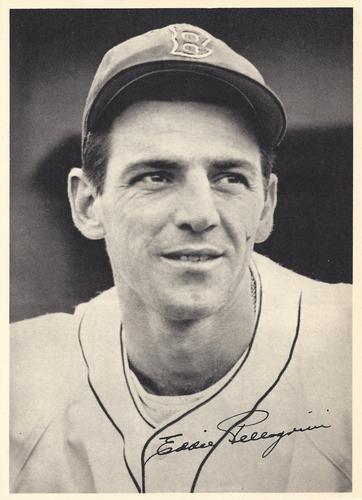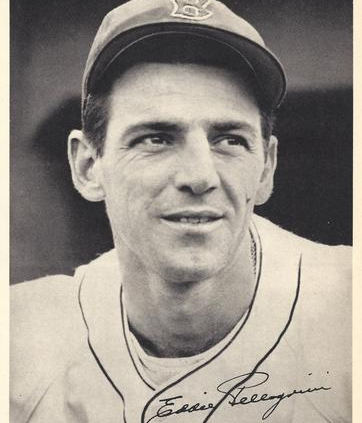April 22, 1946: Boston native Eddie Pellagrini hits game-winning Red Sox homer in first at-bat
 As the first Red Sox season after World War II got underway, the team got off to a very strong start, winning its first five games before dropping the second game of a doubleheader with the Philadelphia Athletics on Sunday, April 21.1
As the first Red Sox season after World War II got underway, the team got off to a very strong start, winning its first five games before dropping the second game of a doubleheader with the Philadelphia Athletics on Sunday, April 21.1
The Washington Senators came to town, managed by Ossie Bluege, and played a Monday afternoon game at Fenway Park against Joe Cronin’s Red Sox.2 The starting pitchers were Mickey Harris for Boston and Sid Hudson for Washington.
Harris was a left-hander who had been out of the game for four years serving in the Army in World War II. He’d been 13-16 in the majors, his most recent win in the 1946 season being a 1-0 shutout of the Senators in Washington on April 18.
Hudson, a right-hander, began his career in 1940, but missed three wartime seasons while serving in the Army Air Force. He had 40 major-league wins to his credit, against 47 defeats.
Both pitchers threw hitless first innings. Both allowed a single in their halves of the second inning. Harris saw a second runner reach on an error and Hudson walked a second man, but neither team scored a run until the top of the third when third baseman Sherry Robertson doubled to the base of the wall in right field and center fielder Stan Spence singled to center, scoring Robertson. The Red Sox went down in order in the bottom of the inning.
Washington took a 4-0 lead in the fourth inning. Shortstop Cecil Travis led off with a triple down the first-base line and into right field. Jerry Priddy reached on an infield single, but Travis had to hold at third base. He scored when catcher Al Evans singled into center field. With runners on first and second, left fielder Ray Goolsby advanced them on a sacrifice.3 Hudson grounded out, but Robertson drove in Priddy and Evans with a single shot through the infield and into right field.4
All it took was two pitches for the Red Sox to get two runs in their half of the fourth. Ted Williams swung at Hudson’s first pitch and singled to right field and second baseman Bobby Doerr, likewise first-pitch-swinging, homered over the left-field wall.
The Senators went down in order in the top of the fifth. Boston catcher Frankie Pytlak singled to start things off, but Harris struck out and Leon Culberson hit into a force play at second base. Shortstop Johnny Pesky (born John Michael Paveskovich) was beaned, the ball striking him on the back of his head and “ricochet[ing] clear into the stands between the backstop screen and the visiting dugout.”5 Shirley Povich wrote in the Washington Post that “the crack of the ball at the back of Pesky’s head was heard stadium-wide.”6
Eddie Pellagrini (“Pelly”) – who had labored in the minors since 1938 – was brought into his first major-league game, to take over as the runner for Pesky at first base. Williams singled to right again, scoring Culberson from second base.
The Red Sox tied it, 4-4, on a leadoff sixth-inning solo home run by first baseman Rudy York, driven into the screen atop the left-field wall, just to the left of the flagpole in center, and “high above the 379 foot mark at the base of the wall.”7
Harris retired Washington with just a walk in the sixth and without a baserunner in the seventh. Then after the first two Boston batters made outs in the bottom of the seventh, Boston native Pellagrini stepped into the box for his first major-league plate appearance. He’d turned 28 years old the month before. He was a veteran, too, having served in the Navy in 1943-45.
On a 2-and-2 pitch, Pellagrini homered into the screen atop the left-field wall, “slightly to the left of the loud speaker horns,” a blow that was “surely a super-duper break-in for a lad making his initial try at the plate in major league company.”8
The Red Sox took a 5-4 lead. Pellagrini’s homer proved the game-winner.
Neither team scored again. Only one more Senator reached base – Travis with a one-out single in the eighth, the only hit off Harris since the fourth inning. Harris struck out the last four batters he faced, closing out the eighth and then retiring the Senators one-two-three in the top of the ninth.
Pellagrini had talent but wasn’t about to replace Johnny Pesky as the Red Sox shortstop. As the Boston Globe’s Harold Kaese wrote, “He could play shortstop for six or seven big league teams, but with the Red Sox he’d have to hit a homer every other time at bat to rate ahead of the talented John Paveskovich.”9
Over the course of eight seasons, “Pelly” played in 563 major-league games, for five teams in all, and accumulated 1,587 plate appearances. He never forgot his first one.10
Recovered from the beaning, Pesky was back in action two days later and played a full game against the visiting Yankees. He played in 153 games in 1946, collecting 208 base hits and batting .335. It was the second of three consecutive seasons in which he had more than 200 hits, leading the league all three years. The Red Sox won the pennant in 1946, but lost the World Series in seven games to the St. Louis Cardinals.
Pellagrini got into just 22 games during the 1946 season, 14 at third base and 9 at shortstop. He hit .211, with only one other home run – against the Yankees on April 25.11 The Red Sox, however, still valued his contribution to the team. As biographer David E. Skelton wrote of Pellagrini’s 1946 season, “Despite the sparing play, on September 24 he was honored as the only homegrown player on the Red Sox and was given a new car.”12
Sources
In addition to the sources cited in the Notes, the author consulted Baseball-Reference.com and Retrosheet.org.
https://www.baseball-reference.com/boxes/BOS/BOS194604220.shtml
https://www.retrosheet.org/boxesetc/1946/B04220BOS1946.htm
Photo credit: Eddie Pellagrini, Trading Card Database.
Notes
1 Boston won the first game after scoring six runs in the bottom of the ninth to tie the score, 11-11, then winning on a walkoff single by Ted Williams in the bottom of the 10th. They were shut out in the second game, 3-0, in a game halted due to encroaching darkness after five innings.
2 Lighting for night games wasn’t installed at Fenway Park until the following season, 1947.
3 This was just the third major-league game in which Goolsby appeared. It was also his last one. He never had a base hit, but contributed with this sacrifice and a later base on balls. He had just one career fielding chance, recording a putout and thus balancing his .000 batting average with a 1.000 fielding percentage.
4 It is of note that Robertson was Joe Cronin’s brother-in-law. Robertson married into the Griffith family, owners of the Senators, and Cronin was married to Mildred Robertson, Clark Griffith’s niece.
5 Pesky was carried from the field on a stretcher, though he never lost consciousness. X-rays proved negative. Team doctor Ralph McCarthy suggested Pesky might have a slight concussion, but predicted he need not be out long. Gerry Moore, “Pellagrini Homer after Mishap Beats Nats, 5-4,” Boston Globe, April 23, 1946: 1. Hudson came to visit Pesky in the Red Sox clubhouse immediately after the game. Pesky quipped, “Hudson isn’t as fast as he was before the war.” Ed Rumill, “Pellagrini’s Major Debut Is Game-Winning Home Run,” Christian Science Monitor, April 23, 1946: 16.
6 Shirley Povich, “Nats Defeated by 3 Bosox Homers, 5-4,” Washington Post, April 23, 1946: 1.
7 Povich.
8 Burt Whitman, “Pellagrini Debut Homer Wins for Sox,” Boston Herald, April 23, 1946: 6.
9 Harold Kaese, “Sox Back in Majors – Williams’ 430-Foot Homer in Washington Emphasized That Fact,” Boston Globe, April 23, 1946: 6.
10 Forty years later, the day in 1986 before the Red Sox hosted an Old-Timers Game at Fenway Park, Pellagrini said, “I’ll never forget April 22, 1946, at Fenway Park. We won the game, 5-4, I belted a game-winning home run over the left-field fence in my first time at bat in the major leagues off Sid Hudson of the Washington Senators. I still send Hudson a Christmas card every year. My seventh-inning homer went over the horn and into the nets. I got into the game when Johnny Pesky was beaned by a pitch thrown by Hudson in the fifth. Manager Joe Cronin sent me in to run for him. I also took his place at shortstop. The next day against the Yankees, I had a double, triple and home run. I should have retired after those first two games.” Neil Singelais, “Old-Timer Memories,” Boston Globe, May 16, 1986: 53. Pellagrini’s memory was slightly off about the following day in that he was 0-for-4, but in his fourth game, on April 25, he did indeed lack only a single in hitting for a near-cycle against the Yankees.
11 In his career, Pellagrini homered 20 times.
12 David E. Skelton, “Eddie Pellagrini,” SABR BioProject. A photograph of Pellagrini receiving the keys to the car from the governor of Massachusetts is on page 16 of the Boston Herald, September 25, 1946.
Additional Stats
Boston Red Sox 5
Washington Senators 4
Fenway Park
Boston, MA
Box Score + PBP:
Corrections? Additions?
If you can help us improve this game story, contact us.


